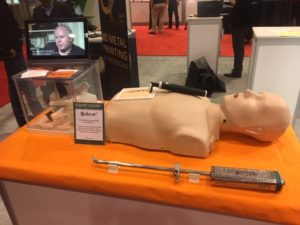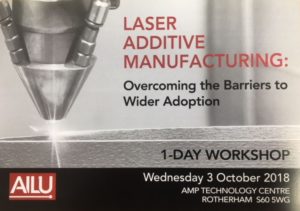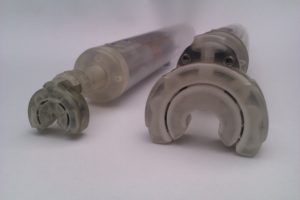by Administrator | Jan 21, 2019 | Uncategorized

Back in May, Sutrue held a prestigious press announcement at the Design Museum in London. Amongst other industry press, we were delighted that the Financial Times attended and have now included Sutrue in a Special Report about the Future of Research & Development in health. In the article, the training of surgeons is explored by Carla Pugh, MD PhD, of Stanford, Richard Trimlett of Royal Brompton Hospital, and Sanjay Purkayastha of Imperial College.
The article can be found here and it is part of a FT Health series which also explores groundbreaking technologies such as photoacoustic imaging, and genome-editing as a new tool for diagnostics. We are delighted to be part of this fascinating series exploring the future of technology in healthcare.
by Administrator | Jan 9, 2019 | Uncategorized

Image: Old design prototypes through to new
With the product development phase of the Sutrue devices close to competition, in Q4 2018, our Managing Director, Stephen Squire, is leading the next phase of the road to market for our revolutionary devices. As with all medical devices, the Sutrue devices need to be put through rigorous medical evaluation and testing, so Stephen has utilised the signposting service at the National Institute for Health Research (NIHR) to begin this process. Sutrue has started to build relationships with NHS Trusts with the aim of establishing suitable partners interested in testing the automated suturing devices.
The NIHR operates twenty Biomedical Research Centers in the UK, and we are extremely pleased that so far four of them have expressed an interest in partnering with us to pilot both the Handheld and Robotic devices. All the institutes who have approached us have an interest in developing specialist surgical techniques. This incredibly positive market response is double the level we were led to expect and reinforces the strong need for the Sutrue devices in the medical industry. We are currently in the process of establishing the most suitable partner to carry out the clinical tests and evaluations.
Furthermore, in order to achieve our forecast revenue, Sutrue only requires two NHS Trusts to procure the Sutrue devices by the end of the third year of sales, so it’s incredibly encouraging that there is already twice as much interest from the medical market. Our market penetration expectations look set to be exceeded early, validating the market demand for these intrinsically safe devices.
The need for the Sutrue devices in the veterinary market is also being explored through discussions with vets and the building of a relationship with a large veterinary distributor who is very interested in the potential of the Sutrue Handheld device. As devices used by vets require significantly less testing, the roadmap to commercialisation in this market is far shorter, with our first case studies expected to be completed within 2019.
The next stage of the commercialisation roadmap requires appropriate funding, so, whilst carrying out market research, we have also recently launched a crowd funding page which can be found here: https:/sutrue.envestry.com/
Investors’ funds will help us to revolutionise the process of medical stitches into a faster, safer and more accurate automated process, which will significantly benefit patients, surgeons, healthcare workers, healthcare institutions and vets throughout the world.

by Administrator | Nov 27, 2018 | Uncategorized
Sutrue were delighted to present our range of automated suturing devices at the prestigious IDTECHEX event, Santa Clara Convention Centre on Wednesday 14th and Thursday 15th November. It was an absolute privilege to exhibit at the conference and we were fortunate to have been allocated one of the best spots in the show, a demonstration area by the main entrance. Our location was perfect for engaging with the 3,500 guests as they entered the show! The image above shows Alex and Bob (the Sutrue dummy) ready to meet attendees.
We were overwhelmed with the positive feedback we received from the range of high-profile attendees who came to our stand. After watching a brief brand video, visitors were quick to grasp the importance of our devices, the need for innovation in the market and the range of potential applications. Many offered to connect us to relevant companies and contacts in their network to help us get our devices through the next steps in our road map – fundraising for the regulation process, manufacturing, then out to market. Following on from the enthusiastic reception, we even managed to squeeze in some last-minute meetings, the outcome from which we hope will have some very positive and far reaching implications.

In addition to exhibiting, Sutrue presented our automated suturing devices during a 20-minute talk on Thursday 15th in Ballroom D. Sutrue were in good company, with fellow presenters including Microsoft, Sony Corporation, GE Global Research, Porsche, Toyota and BASF to name just a few. Our talk was entitled ‘Rapid Prototyping: How using 3D Printing and ‘Multi-Typing’ can reduce costs, time and waste when engineering medical device prototypes’ and aimed to share our experience in designing using 3D printing. If you follow this link you can download presentations from the talks (registration with IDTECHEX needed).
All in all, we had a fantastic conference, enjoyed the general friendliness of the Californians and made some excellent connections for the future road-map of our device!
by Administrator | Oct 19, 2018 | Uncategorized

On 3rd October 2018, the Association of Industrial Laser Users hosted a one-day workshop at the TWI Technology Centre entitled ‘Laser Additive Manufacturing – Overcoming Barriers to Wider Adoption’. This was a poignant workshop topic due to the increasing emergence of additive manufacturing within mainstream manufacturing and the barriers to entry that also present themselves. Subjects covered at the workshop included issues around processes, hardware, software, materials, modelling, certification and testing.
Sutrue recently joined as an AILU member and were honoured to be invited to present at the event. Our talk was based around medical device prototyping and explored the topic of when additive manufacturing (AM) is the best approach to take, as opposed to mass manufacturing. We began our talk with a brief introduction to the Sutrue brand and team, moving on to the device components and how they have been made with additive manufacturing in mind. We then covered the patent of the devices and the industry applications, before moving on to answer the key question – when additive manufacturing is best utilised.
After the presentation, the Sutrue team was pleased to receive a lot of very positive feedback from the audience, in addition to other speakers, about how positive it is to see additive manufacturing being used to create innovative and beneficial products of this nature.
It was a privilege to present at this industry event alongside thought leaders from the University of Birmingham, Laser Additive Solutions, Croft AM, Oxmet, LPW Technology, TWI, Materialise, Sigma Labs, MTC, Lloyds Register, not to mention, major equipment suppliers such as Renishaw.
by Administrator | Aug 10, 2018 | Uncategorized

Ten years ago, on the 12th August 2008, Alex Berry, the founder of Sutrue Ltd, was laid up at home with a broken ankle, when the initial idea of developing an automated suturing device first came to him. It was triggered when he watched a documentary called ‘Super Doctors’ which gave Berry some insight into the problems involved in the process of robotic suturing. Having seen how painstaking the process was, he decided that there must be an easier way to produce a medical stitch. He was keen to keep his brain active whilst his ankle recovered, so on a visit to see his GP, he carried out his first bit of market research into his idea. He asked his GP whether he thought the idea of an automated suturing device was a potentially viable one, and, to his delight, his GP said he thought it was worth a shot. With some basic CAD knowledge behind him and a spark of an idea, Berry set about finding a solution. He soon became obsessed with following the idea to fruition.
Little did Berry know that it would take him ten years to create a working robotic automated suturing prototype and six years to create the handheld device, with many personal and professional highs and lows along the way. To finance the idea in the early days, he sold all his personal assets; his flat, his car and his furniture. At one point in 2011, he lived in a tent for six months, as he couldn’t afford to rent a flat. He later picked up some consulting work which helped him to reintroduce some semblance of ‘normality’ back into his life and this also gave him some funds to continue inventing the device.
In 2012, Berry moved from Jersey to the UK to live with family members and officially set up Sutrue as a company. In the following year momentum for the project really began to gather as he started to meet pivotal thought leaders who would go on to play key roles in the development of the Sutrue device. Firstly, he met Chris Sutcliffe, Professor of Engineering at Liverpool University, whose expertise in engineering and 3D printing enabled Alex to realise the spring plate which is at the heart of the Sutrue device.
Next, Berry met Mr Richard Trimlett (Cardio-thoracic Surgeon and Head of Mechanical Support at the Royal Brompton Hospital). He recalls being on a day trip to the Science Museum in London when he was passing the Royal Brompton Hospital. He was inspired to pop in and ask for the help of a medical expert. He initially asked a porter, which lead to him being put in touch with Mr Richard Trimlett. In Trimlett, Berry found an excellent product guide and between them, over the years, they coined their own working process entitled “Multi-typing”. This involves utilising ‘Rapid Prototyping’ to produce numerous design solutions, then printing, testing, tweaking and reprinting, until eventually producing a product that successfully works and provides the best solution to the end user. This process significantly reduced the cost of the creation of the Sutrue suturing device, probably by a factor of 50 and it also shaved years off the time it would have otherwise taken. It took the creation and subsequent testing of 38 prototypes for Berry and Trimlett to reach the final working prototype. Involving a highly skilled surgeon (and end user) such as Trimlett was a crucial step in the success of the device.
As with any start up, fund raising can be a real challenge. Berry vividly recalls the ‘make or break’ nature of the final day of crowd funding in November 2014. The aim to was to raise £30k to proceed with the patent application for the device, and had this not quite been achieved, then all the funds would be lost. They managed to accomplish it and went onto to submit a patent via another pivotal figure, Doctor Tom Burt, Chartered UK and European Patent Attorney at Abel & Imray.
The subsequent year, 2015, Sutrue were fortunate enough to develop more mutually beneficial relationships, this time with Concept Laser (now GE Additive) whose cutting edge 3D printers have the capability to print the highly detailed metal parts the Sutrue device required. This was another pivotal relationship in the story of the device development and one which Berry was extremely grateful to have developed, as without it, the company would have needed to raise significantly more funds to pay for parts.
In 2016, Sutrue managed to secure enough funding to be able to pay Berry sufficiently to afford to rent somewhere of his own again, and of course to continue the device development further. As funding and product development progressed in leaps and bounds for Sutrue, so too did publicity. Indeed, over the years, Berry’s innovative story has received significant attention. They’ve been covered on BBC Click by Lara Lewington. They have been featured by countless 3D printing and medical press and have been asked to speak at a range of conferences including TCT. One of the highlights has been the receipt of a highly commended certificate at the 2017 TCT Awards.
This year, as Sutrue looks to celebrate the ten-year anniversary of the initial idea, momentum continues to grow. Sutrue has increased its management team, moved into an office near Colchester, were invited to attend a GE Additive thought leadership event in New York, have continued to develop beneficial relationships with prestigious companies such as The Design Museum in London (where the Sutrue handheld device is currently exhibited). Berry and his team are also really excited to have been invited to San Franscico to give a thought leadership talk in Silicon Valley in November!
The next big steps for Sutrue is to redesign the device for manufacturing and put it through the regulation and testing process. It’s been ten years of ups and downs, filled with much uncertainty particularly in the first five years in which Berry didn’t even know for sure that the device would work. He has maintained the progression of the device through having a healthy dose of insanity, extreme resourcefulness, and an inquiring and problem-solving mind. He’s gone against many societal norms to have created two working prototypes of his automated suturing device – the robotic and the handheld, but as the route to market becomes closer and closer, he’s glad to have fought against the odds to see the project through to completion.






